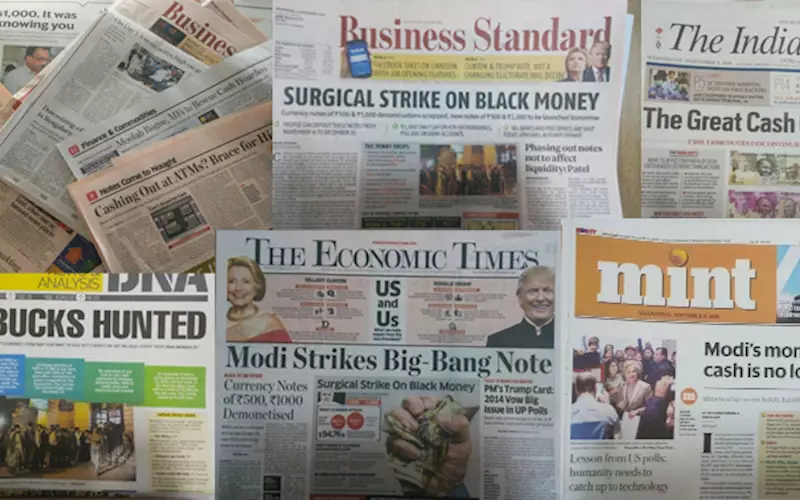Currency denotification: the big picture
The nation went into a scramble on the evening of 8 November after the Prime Minister announced on a television address to the nation that from midnight, Rs 500 and Rs 1,000 currencies will be denotified, meaning these currencies were no longer valid.
11 Nov 2016 | By Rahul Kumar
First, there was panic. What happens to the cash we have on our wallet? Then there was the news that banks and ATM will be closed the next day, and there will be withdrawal limits in ATMs.
Prime Minister Narendra Modi said in his address, “This means that these notes will not be acceptable for transactions from midnight onwards. The five hundred and thousand rupee notes hoarded by anti-national and anti-social elements will become just worthless pieces of paper. The rights and the interests of honest, hard-working people will be fully protected. Let me assure you that notes of one hundred, fifty, twenty, ten, five, two and one rupee and all coins will remain legal tender and will not be affected.”
The government said the recall was to fight the menace of black money. According to the government, a plan is in place. Citizen can exchange their ‘now illegal’ currencies in banks and post offices until 30 December.
Of course, the authorities will issue new currencies of higher denomination later.
Once the panic quelled, citizens hailed the decision as the right one. They were willing to go through the hardship if it meant that the government would have the control over black money.
Then the memes made their appearance, on Facebook and over WhatsApp messages, including a picture of grumpy Pablo Escobar sitting in front of a pile of currency notes and pictures of peanut cones made of Rs 1,000 notes. “America counting votes, India counting notes. Modi surely knows how to steal the thunder,” people shared on Facebook.
On 9 November morning, the news dominated the headline of the newspapers over the news of Donald Trump winning the US Presidential elections.
The Economic Times said, “Modi Strikes Big-Bang Note.” The centre graphic had the title, “Surgical strike on black money”.
The Indian Express called it, “The Great Cash Clean-up.” The paper said the move will affect over 86% of cash; will encourage electronic transactions.
“Black Bucks Hunted,” Screamed the headline of DNA. “Cash is now the new trash,” the newspaper said.
Business Standard also called the development “Surgical strike on black money”. The paper also reported Reserve Bank of India governor Urjit Patel confirming that phasing out of the notes will not affect liquidity.
“Modi’s money mantra: cash is no longer king,” read the Mint headline.
“Black buck stops here, says Modi,” The Hindustan Times reported. The paper also equated the development as Modi’s trump card in the run-up to key assembly polls. The paper also said that the market likely to take a hit.
The Hindu headline was direct, “Rs 500, Rs 1,000 notes no longer legal tenders.”
Meanwhile, Vijay Shekhar Sharma of Paytm tweeted that the country is the biggest beneficiary. “We are a tech start-up, trying to solve financial inclusion and make India proud,” he said.
MK Venu, senior economic journalist, was cautious. He told BBC, “Many Indians are not habitual with banks. First, we need to educate them and habits take time to develop.”
The fine prints
Five hundred rupee and thousand rupee currency notes presently in use will no longer be legal tender.
Persons holding old notes of five hundred or one thousand rupees can deposit these notes in their bank or post office accounts from 10 November until close of banking hours on 30 December 2016 without any limit. Thus, you will have 50 days to deposit your notes and there is no need for panic. Your money will remain yours. You need have no worry on this point.
After depositing your money in your account, you can draw it when you need it.
Keeping in mind the supply of new notes, in the first few days, there will be a limit of ten thousand rupees per day and twenty thousand rupees per week. This limit will be increased in the coming days.
For your immediate needs, you can go to any bank, head post office or sub post office, show your identity proof like Aadhaar card, voter card, ration card, passport, PAN card or other approved proofs, and exchange your old five hundred or thousand rupee notes for new notes. From 10 November until 24 November, the limit for such exchange will be four thousand rupees. From 25 November until 30 December, the limit will be increased.
There may be some who, for some reason, are not able to deposit their old five hundred or thousand rupee notes by 30 December. They can go to specified offices of the Reserve Bank of India up to 31 March 2017 and deposit the notes after submitting a declaration form.
Arrangements will be made at international airports for arriving and departing passengers who have five hundred or thousand rupee notes of not more than five thousand rupees, to exchange them for new notes or other legal tender. Foreign tourists will be able to exchange foreign currency or old notes of not more than Rs 5,000 into legal tender.
There is no restriction of any kind on non-cash payments by cheques, demand drafts, debit or credit cards and electronic fund transfer.














 See All
See All